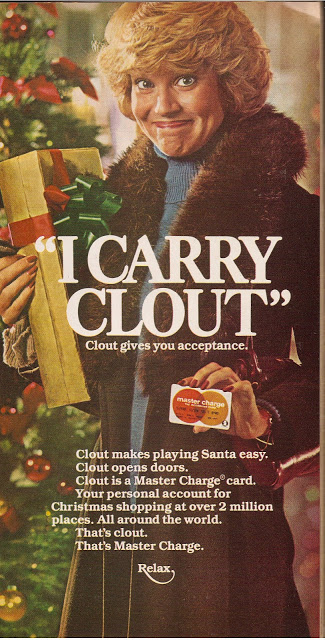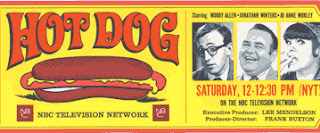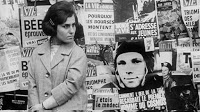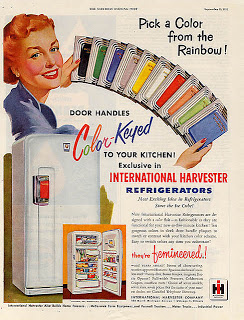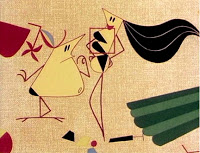Oddball Films presents I Want it All! - Consumer Culture on the Skids, a program of vintage films that fall on both sides of the issue of wealth, consumption, and advertising. With long and short-form commercials, cartoons and capitalist-skewering satire, it's an evening that will make you think differently about pulling out your wallet. Pick the color of you refrigerator to Match Your Mood (1960s), or the color of your shiny new Chevy in The Rainbow is Yours (1950s). Woody Allen and Joanne Worley try to answer that burning question in a segment from the show Hot Dog-How Do They Make Dollar Bills (1971). Learn how credit can change your life, or just burden you with crap in the bizarre and hilarious The Good, Good, Good Life (1974). Mid-century animation marvel Ersatz (1961), features everything you need to have a gas at the beach, until your dreams deflate. The brilliant Canadian filmmaker Arthur Lipsett’s Very Nice, Very Nice(1961) utilizes a unique juxtaposition of sound and image to produce a sardonic re-reading of 1950s consumerism, mass media and popular culture. We all know sex sells; learn the tricks of its best sellers in a Special Edition segment on Frederick's of Hollywood (1970s). Unrelenting advertisements and the implied pressures impede young love in the charming cartoon Harold and Cynthia (1971). Plus, a slew of real commercials and a reel of bizarre faux commercials with the head-scratching It's Not Commercial (1950s).
Date: Thursday, January 10th, 2013 at 8:00pm
Venue: Oddball Films, 275 Capp Street San Francisco (map)
Featuring:
The Good, Good, Good Life (Color, 1977)
One man’s family takes it upon themselves to cheer him up after his wife’s death. They inspire and encourage him to use shiny credit cards to buy many shiny things. This kitsch filled short expresses itself through hilarious musical numbers, overly cheerful characters and a strong sense of doggone goodness that is sure to make you giggle and squeal!
Hot Dog - How Do They Make Dollar Bills? (Color, 1971)
As Dolly Parton once said, “You can never have too much money”. Filmed at Bureau of Printing and Engraving in Washington, D.C. this is one film in a series featuring comedians Jonathan Winters, Jo Anne Worley, and Woody Allen showcasing the various processes that go into the production of dollar bills, from the initial checking of the plates all the way through the extremely detailed counting of the finished bills. Watch it and wish that money was yours!
Harold and Cynthia (Color, 1971)
Explores the impact of advertising on human beings by showing an ordinary man and woman whose attempts to establish a relationship are hindered by the contrived ideals espoused in modern advertisements. Using real advertisements and a stark backdrop, this unique line animation shows the pressures that advertising can put on us as imperfect human beings. With a groovy soundtrack that includes a little Paul Simon.
Match Your Mood (Color, 1968)
Wild, amazing promotional film by Westinghouse touts the latest fad: decorative pop art/psychedelic refrigerator covers. Transforms any kitchen into a swinging go-go party!
It’s Not Commercial (1950s, B+W)
One of the strangest if not THE strangest collection of commercials in Oddball’s 6,000 commercial archive. Created by an unknown studio this collection of short “fake” commercials meant as a parody manages to be simply creepy and weird for no apparent reason. Watch jaw-dropping weirdos that look like rejects from a David Lynch film as they attempt to poke fun at weight loss, deodorant and more.
Ersatz (AKA Surogat) (Color, 1961)
This Yugoslavian animated short was the first foreign animated film to win an Oscar. A fat man goes to the beach and inflates everything he needs. like a boat, a tent, and a shark. He manages to have a fine time until he inflates a girlfriend for himself and realizes that women are too much damn trouble. A gem of mid-century modern style!
Very Nice, Very Nice (B+W, 1961)
From the brilliant avant-garde filmmaker Arthur Lipsett, this film is composed of the rapid juxtaposition of still images and sound fragments. In Very Nice, Very Nice, Lipsett disrupts the representational value of documentary image and sound, moving beyond the genre's aesthetic codes of truth and reliability. The result is a sardonic re-reading of 1950s consumerism, mass media and popular culture. Critically acclaimed it still plays frequently in festivals and film schools around the world.
